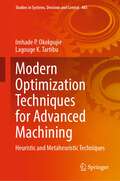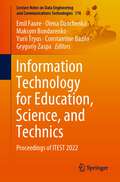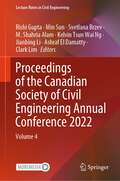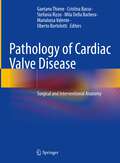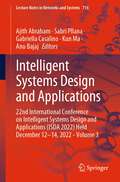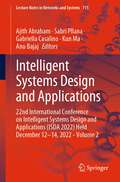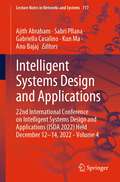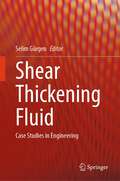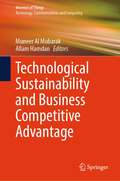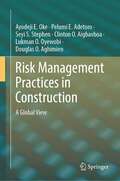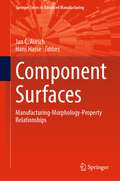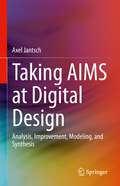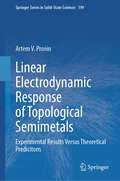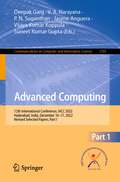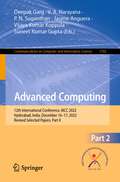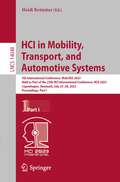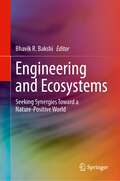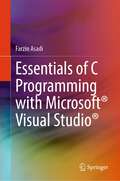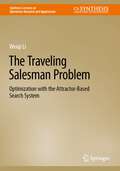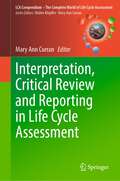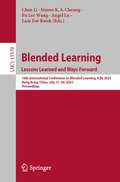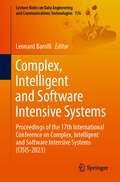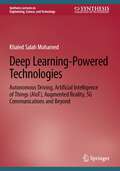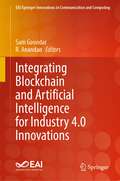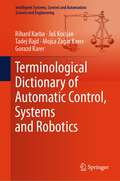- Table View
- List View
Modern Optimization Techniques for Advanced Machining: Heuristic and Metaheuristic Techniques (Studies in Systems, Decision and Control #485)
by Imhade P. Okokpujie Lagouge K. TartibuAdvanced manufacturing via computer numerical machining is the art of producing mechanical components employed in aerospace, automobile, and industrial applications where a high level of accuracy is needed. This book focuses on the nano-machining of aluminum alloy and its optimization. The application of aluminum alloy in the manufacturing industry has increased tremendously due to its lightweight to high strength ratio and high-level resistance to corrosion. However, aluminum alloy has some challenges during the machining and manufacturing stage in order to solve real-life manufacturing challenges in advanced machining operation for sustainable production processes. Therefore, it is a need for the implementation of a general algebraic modeling system (GAMS) and other metaheuristic techniques for problem solving and to effectively develop mathematical models for high accuracy prediction and optimization under nano-lubrication machining conditions. This book discusses majorly on the major three responses in machining such as surface roughness, cutting force, and material removal rate, which will give an excellent guide to undergraduate and postgraduate students, senior research fellows in academia, operational, and strategic staff in manufacturing industries.
Information Technology for Education, Science, and Technics: Proceedings of ITEST 2022 (Lecture Notes on Data Engineering and Communications Technologies #178)
by Emil Faure Olena Danchenko Maksym Bondarenko Yurii Tryus Constantine Bazilo Grygoriy ZaspaThis book gathers selected high-quality full-text papers presented at the VI International Scientific and Practical Conference on Information Technology for Education, Science and Technics (ITEST 2022). The book deals with issues related to mathematical and computer modeling of physical, chemical, and economic processes, with information security, as well as the use of information and communication technology in scientific research, automation of technological processes, and management of complex systems. In this book, the authors explore various aspects of the development of information technology and systems and its application in education, science, engineering, economics, and management. A part of the book is devoted to the application of information and communication technology in higher education, in particular, the creation and implementation of scientific and educational resources in higher education institutions as part of the process of education digital transformation.
Proceedings of the Canadian Society of Civil Engineering Annual Conference 2022: Volume 1 (Lecture Notes In Civil Engineering Ser. #363)
by Rishi Gupta Min Sun Svetlana Brzev M. Shahria Alam Kelvin Tsun Wai Ng Jianbing Li Ashraf El Damatty Clark LimPathology of Cardiac Valve Disease: Surgical and Interventional Anatomy
by Gaetano Thiene Cristina Basso Stefania Rizzo Mila Della Barbera Marialuisa Valente Uberto BortolottiCardiac valve diseases are a major cause of morbidity and mortality around the globe. In third world countries, inflammatory rheumatic valve disease in the young represents an endemic calamity, while in Western countries, degenerative valve diseases like senile calcific aortic stenosis and mitral valve prolapse as a result of mucoid degeneration with incompetence are major causes of death in adults/the elderly. Since the 1960s, surgical valve replacement has been the only treatment option, requiring sternotomy, cardiopulmonary bypass and cardiac arrest. Permanent anticoagulation for mechanical valves and the limited durability of biological valves constituted significant drawbacks; moreover, these surgeries often requires surgical replacement. The cardiac registry at the University of Padua, Italy, has gathered more than twelve hundred cases of failed prosthetic valves, offering a unique resource for teaching and research. Conservative valve repair using minimally invasive technique showed that replacement of the native valve with sternotomy can be spared. Moreover, in the last decade venous or arterial approaches like TAVI were developed. Presenting the essential surgical and interventional anatomy and pathology in detail, this book offers a valuable tool for cardiologists, cardiac surgeons and pathologists, as well as people in training and scientists working in the field of medical devices and biological compatibility.
Intelligent Systems Design and Applications: 22nd International Conference on Intelligent Systems Design and Applications (ISDA 2022) Held December 12-14, 2022 - Volume 3 (Lecture Notes in Networks and Systems #716)
by Ajith Abraham Sabri Pllana Gabriella Casalino Kun Ma Anu BajajThis book highlights recent research on intelligent systems and nature-inspired computing. It presents 223 selected papers from the 22nd International Conference on Intelligent Systems Design and Applications (ISDA 2022), which was held online. The ISDA is a premier conference in the field of computational intelligence, and the latest installment brought together researchers, engineers, and practitioners whose work involves intelligent systems and their applications in industry. Including contributions by authors from 65 countries, the book offers a valuable reference guide for all researchers, students, and practitioners in the fields of computer science and engineering.
Intelligent Systems Design and Applications: 22nd International Conference on Intelligent Systems Design and Applications (ISDA 2022) Held December 12-14, 2022 - Volume 2 (Lecture Notes in Networks and Systems #715)
by Ajith Abraham Sabri Pllana Gabriella Casalino Kun Ma Anu BajajThis book highlights recent research on intelligent systems and nature-inspired computing. It presents 223 selected papers from the 22nd International Conference on Intelligent Systems Design and Applications (ISDA 2022), which was held online. The ISDA is a premier conference in the field of computational intelligence, and the latest installment brought together researchers, engineers, and practitioners whose work involves intelligent systems and their applications in industry. Including contributions by authors from 65 countries, the book offers a valuable reference guide for all researchers, students, and practitioners in the fields of computer science and engineering.
Intelligent Systems Design and Applications: 22nd International Conference on Intelligent Systems Design and Applications (ISDA 2022) Held December 12-14, 2022 - Volume 4 (Lecture Notes in Networks and Systems #717)
by Ajith Abraham Sabri Pllana Gabriella Casalino Kun Ma Anu BajajThis book highlights recent research on intelligent systems and nature-inspired computing. It presents 223 selected papers from the 22nd International Conference on Intelligent Systems Design and Applications (ISDA 2022), which was held online. The ISDA is a premier conference in the field of computational intelligence, and the latest installment brought together researchers, engineers, and practitioners whose work involves intelligent systems and their applications in industry. Including contributions by authors from 65 countries, the book offers a valuable reference guide for all researchers, students, and practitioners in the fields of computer science and engineering.
Shear Thickening Fluid: Case Studies in Engineering
by Selim GürgenShear Thickening Fluid: Case Studies in Engineering provides a set of case studies and research data on the cutting-edge technology of shear thickening fluid (STF) to assist readers with understanding the adaptive behavior of STF in different engineering applications. Various engineering designs are adapted by including STF to take advantage of this smart material in the areas of protective structures, energy-absorbing systems, vibration-damping devices, and surface finishing operations. A companion volume to the book Shear Thickening Fluid: Theory and Applications, this volume will be a valuable reference for practicing engineers, researchers, and scientists working in advanced materials, smart structures, and intelligent engineering applications.
Technological Sustainability and Business Competitive Advantage (Internet of Things)
by Muneer Al Mubarak Allam HamdanThis book discusses advanced technological solutions in Industry 5.0 that can be used for business competitive advantage and sustainability. The book presents tools that can help reduce time and make use of data in an efficient way while using resources efficiently and sustainably. The book aims to highlight technological sustainability through promoting innovations, improving social development, and providing green products that benefit the society. The authors discuss the recent technological advancements such as Artificial Intelligence (AI), Internet of Things (IoT), Financial Technology (FinTech), Big Data, and Blockchain. They also discuss the benefits of incorporating such technologies in areas such as green supply chain, storage technology, Internet banking, and nanotechnology. The target audience of this book includes all interested individuals and institutions in the fields of engineering, business, technology, and public services. The book provides insights and solutions to many issues and creates opportunities for further sustainability.
Risk Management Practices in Construction: A Global View
by Ayodeji E. Oke Pelumi E. Adetoro Seyi S. Stephen Clinton O. Aigbavboa Lukman O. Oyewobi Douglas O. AghimienThis volume describes risk management practices in the construction industry in selected countries, with an emphasis on developing countries and how these countries can learn from the practices in more developed ones. Risk management in the construction industry can be difficult to understand due to the various complex procedures that are involved and to the unique concerns and contexts associated with each project. The industry has been a key contributor to the economic and social development of many countries of the world and is increasingly incorporating sustainability into its practices. However it is plagued by various risks that can affect the quality, cost, time and overall sustainability of projects. Therefore, there is need to effectively manage risk in order to ensure timely completion of construction projects in good quality and within budget, which in turn results in more efficient and often more sustainable practices. The book is divided into four parts. The first section features a primer on risk management practices as they pertain to the construction industry. The second part dives in to describe risk management in selected developing countries, including Malaysia, Qatar, Saudi-Arabia, South Africa, Sri-Lanka and Tanzania, as well as the city of Hong Kong. The third section describes the construction risk management practices of a selection of more developed countries with known risk management institutes and established practices of risk management. These countries include Australia, Canada, Sweden and United States of America. The fourth part offers a general overview of the definition, concepts and process of risk management based on reviewed literature. It also discusses the benefits of effective risk management to clients and to project teams, especially from the perspective of ensuring sustainability. This last section also summarizes the risk management practices in both developing and developed countries for the purpose of improving the practices in the former by learning from the latter.
Component Surfaces: Manufacturing-Morphology-Property Relationships (Springer Series in Advanced Manufacturing)
by Jan C. Aurich Hans HasseThis book sheds new light on component surfaces and the scientific fundamentals of their creation, characterization, and application. The book also provides a new interdisciplinary perspective on the topic, studying component surfaces with a multiscale approach and linking fundamental and applied research. The book builds on the success of the coordinated research project funded by Deutsche Forschungsgemeinschaft (DFG) from 2011 – 2023: the CollaborativeResearch Center CRC 926 “Microscale Morphology of Component Surfaces (MI-COS)”, in which, over the years, 100+ researchers have co-operated at the University of Kaiserslautern, Germany, and affiliated institutes, yielding 500+ scientific papers in journals from different fields of science and engineering. Divided into 2 main parts, the book starts with an introduction to the concept of Manufacturing-Morphology-Property (MMP) Relationships and dives into the fundamentals and technologies, including topics such as the geometrical, microstructural, and chemical characterization, indentation, and scratching on the nanoscale, micro milling and micro grinding, cryogenic machining, cold spraying, and additive manufacturing. In the first part, readers discover more about the interactions between particles and surfaces, the interrelationship of manufacturing, surface morphology and properties of titanium, the influence of manufacturing and load conditions on the phase transformation and fatigue of austenitic stainless steels, and the influence of surface morphology on fatigue and tribological behavior of Transformation-Induced-Plasticity (TRIP)/Twinning-Induced Plasticity (TWIP) Steels. The second part of this book is devoted to the applications of component surfaces, covering topics like the manufacturing of areal material measures, MMP relationships for rotating shaft sealing systems, the influence of the surface morphology on rolling bearing life under mixed lubrication, MMP relationships for chain joints, and MMP for biofilms. Scientists and engineers who deal with the influence of surfaces on macroscopic properties of components and who are interested in designing and manufacturing these surfaces to obtain desired component properties will understand the appeal of this work. Given its interdisciplinary breadth, the book also appeals to scholars and professionals in the fields of mechanical engineering, process engineering, and physics.
Taking AIMS at Digital Design: Analysis, Improvement, Modeling, and Synthesis
by Axel JantschThis is an introductory textbook for courses in Synchronous Digital Design that enables students to develop useful intuitions for all of the key concepts of digital design. The author focuses this tutorial on the design flow, which is introduced as an iterative cycle of Analysis, Improvement, Modeling, and Synthesis. All the basic elements of digital design are covered, starting with the CMOS transistor to provide an abstraction upon which everything else is built. The other main foundational concepts introduced are clocked synchronous register-transfer level design, datapath, finite state machines and communication between clock domains.
Linear Electrodynamic Response of Topological Semimetals: Experimental Results Versus Theoretical Predicitons (Springer Series in Solid-State Sciences #199)
by Artem V. ProninThis book provides a model description for the electromagnetic response of topological nodal semimetals and summarizes recent experimental findings in these systems. Specifically, it discusses various types of topological semimetals – Dirac, Weyl, nodal-line, triple-point, and multifold semimetals – and provides description for the characteristic features of the linear electrodynamic response for all these types of materials.Topological semimetals possess peculiar bulk electronic band structure, which leads to unusual electrodynamic response. For example, the low-energy inter-band optical conductivity of nodal semimetals is supposed to demonstrate power-law frequency dependence and the intra- and inter-band contributions to the conductivity are often mixed. Further, the magneto-optical response is also unusual, because of the non-equidistant spacing between the Landau levels. Finally, in semimetals with chiral electronic bands, e.g. in Weyl semimetals, the simultaneous application of parallel magnetic and electric fields leads to the chiral anomaly, i.e. to a misbalance between the electrons with diffident chiralities. This misbalance affects the electrodynamics properties of the material and can be detected optically. All these points are addressed here in detail.The book is written for a wide audience of physicists, working in the field of topological condensed matter physics. It gives a pedagogical introduction enabling graduate students and non-experts to familiarize themselves with the subject.
Advanced Computing: 12th International Conference, IACC 2022, Hyderabad, India, December 16–17, 2022, Revised Selected Papers, Part I (Communications in Computer and Information Science #1781)
by Deepak Garg V. A. Narayana P. N. Suganthan Jaume Anguera Vijaya Kumar Koppula Suneet Kumar GuptaThis two-volume set constitutes reviewed and selected papers from the 12th International Advanced Computing Conference, IACC 2022, held in Hyderabad, India, in December 2022.The 72 full papers and 6 short papers presented in the volume were thorougly reviewed and selected from 415 submissions. The papers are organized in the following topical sections: AI in industrial applications; application of AI for disease classification and trend analysis; design of agricultural applications using AI; disease classification using CNN; innovations in AI; system security and communication using AI; use of AI in human psychology; use of AI in music and video industries.
Advanced Computing: 12th International Conference, IACC 2022, Hyderabad, India, December 16–17, 2022, Revised Selected Papers, Part II (Communications in Computer and Information Science #1782)
by Deepak Garg V. A. Narayana P. N. Suganthan Jaume Anguera Vijaya Kumar Koppula Suneet Kumar GuptaThis two-volume set constitutes reviewed and selected papers from the 12th International Advanced Computing Conference, IACC 2022, held in Hyderabad, India, in December 2022.The 72 full papers and 6 short papers presented in the volume were thorougly reviewed and selected from 415 submissions. The papers are organized in the following topical sections: AI in industrial applications; application of AI for disease classification and trend analysis; design of agricultural applications using AI; disease classification using CNN; innovations in AI; system security and communication using AI; use of AI in human psychology; use of AI in music and video industries.
HCI in Mobility, Transport, and Automotive Systems: 5th International Conference, MobiTAS 2023, Held as Part of the 25th HCI International Conference, HCII 2023, Copenhagen, Denmark, July 23–28, 2023, Proceedings, Part I (Lecture Notes in Computer Science #14048)
by Heidi KrömkerThis book constitutes the refereed proceedings of the 5th International Conference on HCI in Mobility, Transport, and Automotive Systems, MobiTAS 2023, held as part of the 25th International Conference, HCI International 2023, held in Copenhagen, Denmark, in July 2023. The total of 1578 papers and 396 posters included in the HCII 2022 proceedings was carefully reviewed and selected from 7472 submissions. The MobiTAS 2023 proceedings were organized in the following topical sections: Part I: Autonomous and Assisted Driving; Cooperative and Intelligent Transport Systems; Urban Mobility; and Sustainable Mobility. Part II: Driver Behavior and Performance; Designing Driver and Passenger User Experience; and Accessibility and Inclusive Mobility.
Engineering and Ecosystems: Seeking Synergies Toward a Nature-Positive World
by Bhavik R. BakshiThis book demonstrates how the inclusion of nature in engineering decisions results in innovative solutions that are economically feasible, ecologically viable, and socially desirable. It advances progress toward nature-positive decisions by protection and restoration of ecosystems and respect for ecological boundaries. The topic of this book is an active area of academic research, and leading companies are including goals associated with ecosystem services in their sustainability plans. This book is the first collection of methods and applications that explicitly include the role of nature in supporting engineering activities and describes the role that ecosystems play in supporting technology and industry. It describes approaches, models, applications, and challenges for innovation and sustainability that will be useful to students and practitioners.
Essentials of C Programming with Microsoft® Visual Studio®
by Farzin AsadiThis book provides a compact but comprehensive treatment that guides readers through the C programming language with Microsoft® Visual Studio®. The author uses his extensive classroom experience to guide readers toward deeper understanding of key concepts of the C language. Each concept and feature of the language is presented as a short lesson, illustrated by practical worked examples to aid student self study. The book will appeal to a broad range of students who are required to study the C programming language.
The Traveling Salesman Problem: Optimization with the Attractor-Based Search System (Synthesis Lectures on Operations Research and Applications)
by Weiqi LiThis book presents a new search paradigm for solving the Traveling Salesman Problem (TSP). The intrinsic difficulty of the TSP is associated with the combinatorial explosion of potential solutions in the solution space. The author introduces the idea of using the attractor concept in dynamical systems theory to reduce the search space for exhaustive search for the TSP. Numerous examples are used to describe how to use this new search algorithm to solve the TSP and its variants including: multi-objective TSP, dynamic TSP, and probabilistic TSP. This book is intended for readers in the field of optimization research and application.
Interpretation, Critical Review and Reporting in Life Cycle Assessment (LCA Compendium – The Complete World of Life Cycle Assessment)
by Mary Ann CurranThis book discusses the phase “Interpretation” in an outstanding way. According to the opinio communis within the LCA community, “Interpretation” is classified as fourth phase of the LCA framework. However, referring to ISO 14040, this book defines “Interpretation” according to its function in the LCA framework, and this means that “Interpretation has a much broader influence than generally accepted. It overarches goal and scope, inventory analysis and impact assessment. Conclusions are drawn from the results of the inventory and the impact assessment, and recommendations refer to the objective of the study, the goal and scope phase. Likewise to be considered are the defined framework conditions, the reasons for carrying out the study as well as the context of the intended applications and the target groups of the results). A second highlight of this book concerns “Interpretation” as discussed in conjunction with Critical Review and Reporting, which is an outstanding approach. The relationship between interpretation and critical review can be seen in the fact that interpretation is a kind of structured preparation of a critical review; in practice, the performance of a critical review can be made much easier if the preparers of a life cycle assessment study very carefully follow the requirements that are specifically placed on the interpretation. Because the critical review is the independent quality control of an LCA, the results improve the credibility of reporting. The critical review helps to avoid text weaknesses and potential misunderstandings because these aspects will easier be realized by independent readers from different viewpoints. The reviewers thus also represent the first readership of a study and can help to ensure that the specific requirements for good and clear reporting of life cycle assessments are met. Sound reporting needs clear conclusions.
Blended Learning: 16th International Conference on Blended Learning, ICBL 2023, Hong Kong, China, July 17-20, 2023, Proceedings (Lecture Notes in Computer Science #13978)
by Chen Li Simon K. S. Cheung Fu Lee Wang Angel Lu Lam For KwokThis book constitutes the refereed proceedings of the 16th International Conference on Blended Learning, ICBL 2023, held in Hong Kong, China, on July 17-20, 2023. The 24 papers presented in this volume were carefully reviewed and selected from 57 submissions. The papers are organized in topical sections named: smart classroom and digital literacy; online and distant learning; content and pedagogy development for blended learning; gamification and lnteractive learning snvironment; learning analytics and big data in education.
Complex, Intelligent and Software Intensive Systems: Proceedings of the 17th International Conference on Complex, Intelligent and Software Intensive Systems (CISIS-2023) (Lecture Notes on Data Engineering and Communications Technologies #176)
by Leonard BarolliThis book aims to deliver a platform of scientific interaction between the three interwoven challenging areas of research and development of future ICT-enabled applications: software intensive systems, complex systems and intelligent systems.Software intensive systems are systems, which heavily interact with other systems, sensors, actuators, devices, other software systems and users. More and more domains are involved with software intensive systems, e.g., automotive, telecommunication systems, embedded systems in general, industrial automation systems and business applications. Moreover, the outcome of web services delivers a new platform for enabling software intensive systems.Complex systems research is focused on the overall understanding of systems rather than its components. Complex systems are very much characterized by the changing environments in which they act by their multiple internal and external interactions. They evolve and adapt through internal and external dynamic interactions. The development of intelligent systems and agents, which is each time more characterized by the use of ontologies and their logical foundations, builds a fruitful impulse for both software intensive systems and complex systems. Recent research in the field of intelligent systems, robotics, neuroscience, artificial intelligence and cognitive sciences are very important factor for the future development and innovation of software intensive and complex systems.
Deep Learning-Powered Technologies: Autonomous Driving, Artificial Intelligence of Things (AIoT), Augmented Reality, 5G Communications and Beyond (Synthesis Lectures on Engineering, Science, and Technology)
by Khaled Salah MohamedThis book covers various, leading-edge deep learning technologies. The author discusses new applications of deep learning and gives insight into the integration of deep learning with various application domains, such as autonomous driving, augmented reality, AIOT, 5G and beyond.
Integrating Blockchain and Artificial Intelligence for Industry 4.0 Innovations (EAI/Springer Innovations in Communication and Computing)
by Sam Goundar R. AnandanThis book discusses the convergence of artificial intelligence (AI) and Blockchain and how they can work together to help reach the goals of Industry 4.0. The authors first discuss how AI and Blockchain can help increase performance in business. The authors go on to discuss how the technologies can integrate to provide a competitive edge for businesses through improvements in big data, which has allowed firms to organize huge datasets into structured components that computers can process quickly. The authors also cover security implications and how AI and Blockchain can act as a double-edged sword against cyber-attacks. Impacts in programming, calculations, robotization, robots, and equipment are also discussed. This book caters to an extensive cross-sectional and multi-disciplinary readership. Academics, researchers and their students in topics such as artificial intelligence, cyber-physical systems, ethics, robotics, safety engineering, and safety-critical systems should find the book of value.
Terminological Dictionary of Automatic Control, Systems and Robotics (Intelligent Systems, Control and Automation: Science and Engineering #104)
by Rihard Karba Juš Kocijan Tadej Bajd Mojca Žagar Karer Gorazd KarerThis dictionary contains terms from the fields of automatic control, which includes mathematical modelling, simulation of dynamic systems, automation technology with its corresponding elements, and robotics. It also includes signal processing, information technologies and production technologies.The terminological dictionary is primarily aimed at experts and students who deal with control technology and dynamic systems in both technical and non-technical domains. To be able to use the dictionary, at least basic knowledge in this field is required. In the dictionary users will find concise terminological definitions. A concept may be designated by different terms; therefore, cross-references are used. The aim of the dictionary is to collect and unify – at least to an achievable extent – the terminology in the field of automatic control, dynamic systems and robotics.
